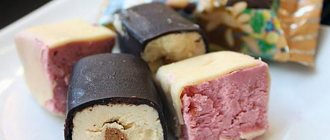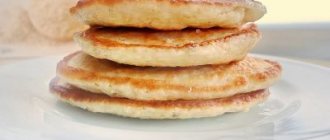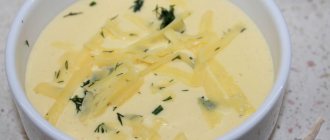Hard cheeses
Commonly known as greetings from different countries of the world.
- Very popular Dutch "Edamian". Its cousin is "Gouda". In our country it is known as the famous “Dutch” cheese and its calorie content is 352 kcal. Many countries produce these hard cheeses for cutting, which indicates their popularity and generally recognized taste. If you have a good sense of smell, you will easily recognize the nutty flavor, which intensifies as the product matures. And for our “fitness nutrition” theme, these cheeses are almost perfect.
In this group of cheeses. 25% proteins and 28% fats are clear evidence of its suitability for fitness diets and breakfasts and desserts.
- Here's greetings from good old England - the famous "Cheddar". World celebrity! Ripening for 2-3 months, in order to bring us a feast of taste! With a sour-nutty taste and a “bouquet” of data - 392 kcal, fat content of 32% and 23% protein.
- Do you like French cheeses? What about Munster? It contains 365 kcal, fat content 29, protein – more than 26%. Give it a try. You should like it. Or maybe you prefer Limbourg cheese, or Livaro? And it’s definitely worth trying “romadour” or “tilsiter”.
- If you prefer hard “Emmental” cheeses, then you are a clear fan of everything Swiss. But in Germany this cheese is known as "Algaussky". Apparently in France, Austria and Finland they also love this cheese, since they produce it at home.
- Another Swiss cheese, Gruyère, is for lovers of hard, hard varieties, slightly fattier than Parmesan and with a calorie content of 396 kcal.
- And here is the famous Parmesan cheese with its calorie content of 292 kcal, called the king of cheeses. This cheese is consumed grated. In its native Italy, all its varieties are classified as the hardest cheeses with a fat content of 32%. Very informative information about its production. It turns out that cheese “ripens” for 10 or more years. But the cheese that is usually sold is 3-4 years old. And according to experts, with years of aging it becomes tastier, harder, and you need a hammer to “crack” it! And another ritual for checking maturity and “health” (a kind of OTC) - tapping special. cheese being taken out of the cellars with hammers. If something is wrong - rejection, grinding, drying and packaging.
Love yourself? Then “pamper”! – enjoy only fresh grated cheese! There is no comparison with what is already packaged!
- My favorite cheese with huge holes! Cheese "Maasdam" with a calorie content of 350 kcal. Dutch cheesemakers created this gastronomic delicious unique in defiance of the cheese makers of Switzerland and the famous Emmental cheese. Do you know that there are different types of “holes”? – Cheeses “Royal”, “Frontera”, “Jagibo”, “Frico”. And all this is “Maasdam”! It often seems to me that the more holes in the body of the cheese, the tastier and healthier it is!
Cheese for breakfast on a diet. Cheese diet for weight loss. Minus 7 kg in 10 days
Girls who are thinking about the cheese diet, remember that it is not suitable for everyone. The first point is the specific taste of cheese, which not everyone likes. The second point is that there may be intolerance to this product.
Cheese is a dietary product; it contains substances that affect digestion. This dairy product boasts a rich content of nutrients. Cheese contains vitamins A, B2 and B12, which help the body fight colds, improve vision and help produce energy. Cheese also contains microelements (amino acids, calcium, zinc, phosphorus), which help the cells of the body to function actively.
Pros of the cheese diet:
- Cheese contains a large amount of essential vitamins and microelements for the body;
- easy digestion of cheese and saturation of the body with protein;
- the diet is effective because you can lose up to 7 kg in 10 days;
- in the cheese diet there is no feeling of hunger, so it is easily tolerated;
- you don’t need to cook food for a long time, therefore, you spend less time in the kitchen and less time reaching for the refrigerator;
- the diet has the principle of fractional meals, which means you will be full;
- After a diet, it is easy to return to your normal diet.
Disadvantages of the diet:
- excluding fruits and vegetables from the diet, the body is deprived of a number of useful microelements and vitamins;
- It’s hard for those who don’t have a passion for cheese.
The cheese diet is considered a protein diet. Cheese contains useful substances that do not allow the body to weaken. The body receives the required amount of elements, but by limiting the diet, fat reserves are lost.
Cheese varieties are distinguished by fat content. For a cheese diet, it is recommended to stick to cheeses with a fat content of 10-12%. You can also use hard or soft varieties that have a reduced calorie content.
Nutritionists advise going on a cheese diet in the summer. The human body, due to its characteristics, reduces the need for meat products in the summer. Consequently, the body becomes deficient in animal proteins, which can be restored by frequent consumption of cheese.
It is necessary to leave this diet not abruptly, but gradually. Due to the nutritional value of cheese, the body will not urgently ask for other foods. Therefore, bread, vegetables and fruits should be introduced into the diet for 3-5 days. To maintain the effect obtained, it is recommended to maintain fractional meals. Such nutrition is considered beneficial for the body.
Contraindications for the cheese diet:
- diseases of the gastrointestinal tract;
- impaired metabolism;
- poor tolerance to dairy products;
- pregnancy and lactation period;
- diabetes ;
- hypertension, atherosclerosis and angina pectoris.
If you decide to go on a cheese diet, you should first consult a doctor or nutritionist. They will help in correctly calculating the amount of food and the length of time of the diet, because this will depend on your weight and expected results.
Cheese diet for weight loss
There are several types of this diet. The difference is in the duration and range of permitted products.
Types of diets:
- A cheese diet lasting 10 days will help you lose 5 extra pounds. The duration of this diet in some cases can be reduced to 8 days, but it is not advisable to increase it. Eating this type of diet should be done frequently, but the portions should be small. The recommended meal is every 2.5 hours. Breakfast should be at 8 am, and dinner no later than 20.00.
- This type of cheese diet allows you to eat 3 times a day. Duration - a week or 10 days, depending on the desired results.
- Unusual wine and cheese diet. The duration of the diet is only 2 days. With the right approach, you can lose up to 1.5 kg. For those who want to lose some weight, it is well suited.
Sample menu for this diet:
- Breakfast: coffee or tea without sugar;
- second breakfast: soft-boiled chicken egg;
- lunch: boiled beef or chicken - 200 g;
- afternoon snack: low-fat hard cheese - 150 g;
- dinner: low-fat cottage cheese - 250 g;
- drink a glass of kefir before 20.00.
During the diet, it is recommended to take a large amount of fluid, preferably green tea, herbal tea or pure water.
This diet can be repeated every 3 months, if, of course, you feel good after it.
Diet menu:
- breakfast: low-fat cottage cheese - 200 g or hard cheese - 100 g and coffee without cream and sugar;
- lunch: light soup without potatoes, vegetable salad with cheese, coffee;
- dinner: cheese - 70 g and low-fat yogurt or kefir.
In this type of diet, fruits, sugar and juices are excluded from the diet. It is possible to add blue cheeses to the menu, but then you will need to reduce the portions.
The diet menu contains 5 meals. Each meal contains: hard cheese - 100 g with a crust of bread and dry white wine - 50 ml. Between meals you need to drink an average of 0.5 liters of liquid (green tea, herbal decoction or pure water).
You can find a diet that is more suitable for you. Treat your diet correctly, don’t give up, have willpower and the result will come.
Semi-hard Blue cheeses
- French "Roquefort". Aristocratic and famous. Recognized all over the world. Know that the “signature” Roquefort is strictly made from sheep’s milk, fermented into a cheese mass, to which “grown from rye bread” is added. The production of this specific cheese has become a monopoly for the owners of the natural grottoes where all this is located.
.If you see a red seal on the packaging shell - an oval with a sheep - it means this is a branded product. Slightly crumbling with streaks of mold. Don’t be afraid for your figure – the calorie content of cheese is 332 kcal, fat content is 30%, and protein is only 17%.
- Almost all over the world, soft (although it belongs to the group of semi-hard) Italian cheese “Gorgonzola” is produced - a notable competitor of “Roquefort”. - a rare guest on sale, with a strong smell and pungent taste. But there are gentle versions of this cheese - less pungent and piquant in taste. With less fat content than Roquefort (26%) and a calorie content of 310 kcal, it is an excellent option for fitness nutrition.
- Camembert cheese, not very common outside France, has a calorie content of 291 kcal (fat content 23%, protein 21%). It is brewed almost throughout the country, but gourmets say that the best is still Norman, where it comes from.
- Another cheese from the galaxy of famous and French ones. "Brie." With a delicate taste and a nutty aftertaste. With a calorie content of 291 kcal and a fat content of 23%. Cheese makers in France offer cheese varieties to lovers: “brie de Melun”, “brie de Coulommier”.
Myths
Some people who are lactose intolerant believe that they should not eat cheese. In fact, compared to other dairy products, cheese contains too little lactose. Therefore, the product can be safely consumed regularly in small quantities.
There is an opinion that eating a lot of cheese leads to constipation. But there is absolutely no scientific evidence about its effect on the functioning of the gastrointestinal tract.
To lose weight, you don't have to eat only low-fat varieties. For example, even though the calorie content of Russian cheese is 363 units per 100 g, you can eat it. But at the same time, it is necessary to regularly calculate the caloric content of the diet in order to maintain a calorie deficit.
Soft exotic cheeses
- This is a Greek pearl, perhaps even the origin of Mediterranean cheeses, the famous “feta” - a soft cheese made from traditional sheep's milk. With a special recipe for ripening in brine. Its calorie content is 290 kcal, fat content is 24%.
- Since ancient times, Mediterranean countries and the mountainous regions of the Caucasus have been preparing a relative of feta cheese, feta, and mozzarella, soft homemade cheese “Adygeiskiy” with a calorie content of 240 kcal. And how nutritionists love to recommend this cheese! Try it with herbs and wine. Highlanders use it daily and many become long-livers. Maybe we should try it too?
- Cheese technologists based on standard traditional cheese using unique technologies created “Oltermanni” cheese with a calorie content of 270.00 kcal, 17% fat content, and a soft creamy taste. This “yummy” is ideal for a diet - the product is free of lactose and preservatives, high in protein and calcium, and salt is minimized.
Manufacturing technology
Production goes through several stages. First, the milk is purified. To prevent microbial exposure, cooling is carried out. The cheese must be aged for 60 days. They prepare for coagulation, and the coagulation process itself with the addition of calcium chloride. The finished curd is crushed, the whey is removed, and a fine grain of cheese is obtained. Then a second heating is done, which removes the water and forms the heads. The cheese is pressed, salted and placed in special chambers to mature. When dehydrating, carefully monitor acidity.
The composition of the product according to GOST and its production technology is characterized by a high degree of lactic acid fermentation and a low temperature of the second heating. For the fermentation process, a lactic acid mesophilic streptococcal starter is used, and the temperature is changed three times when the heads are ripened. Such long-term production preserves the uniqueness of the aroma.
Processed cheeses

- The Swiss didn’t have enough of their ordinary cheeses, so back in the 50s of the last century they invented a way to make “processed” cheese with a calorie content of 294 kcal, by heat treating rennet (again this is a funny word) cheeses. And they still produce such a product under the Kraft brand. Flavoring fillers are added to the mass - salt, spices, butter, sugar, mushrooms, bacon. The result is a tasty paste or layer with different flavors.
- And if you form “sausages” from the processed cheese mass (hence the name) and smoke it in special smokehouses-chambers, you get “sausage” cheese with a calorie content of 275 kcal. As a result, we get what we are used to having for breakfast - a refined aroma of smoked meat with a high content of vitamins A, folic acid, phosphorus, calcium and potassium.
Compound
To prepare 450 g of product you need 4.5 liters. milk. The concentration of nutrients in cheese is off the charts. The product, in particular, is rich in the following beneficial substances:
- vitamins A, D, K, C, E;
- vitamins B6 and B12;
- vitamin B1, B3, B7 and B5 (better known as pantothenic acid);
- folate (B complex vitamin);
- calcium;
- riboflavin;
- iodine;
- zinc and copper;
- chromium;
- iron;
- phosphorus;
- magnesium;
- unsaturated fatty acids - Omega-3 and Omega-9.
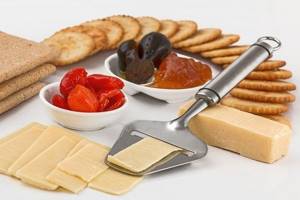
Cheeses for pizza
- Common truths and culinary taboos - very popular pizzas traditionally use the famous low-fat Mozzarella cheese with a calorie content of 240 kcal. This is a cheese making classic! But you need buffalo milk (for the branded one). You can, of course, replace it with a standard cow one. You can do a lot in cooking, but the taste will be a little “off”. The fat content remains the same – 24%.
- An excellent fitness menu is Brynza. 20% fat, calorie content 260 kcal. And most importantly, it’s great for all kinds of vegetable salads.
- A specifically brined cheese from Georgia, the delicious and popular “Suluguni”. Calorie content 290 kcal, fat content 24%.
- Delicate consistency and the name “Russian” cheese, famous since the times of the USSR, with a familiar calorie content of 360 kcal and a fat content of 29%. Prepared with rennet starter. Having become a brand of the country of origin, this semi-hard cheese fascinates with its familiar lace of small holes on the cut. Good on sandwiches and pizza.
Cottage cheese BZHU. Cottage cheese 5%
Cottage cheese is a traditional fermented milk product made from cow's milk. Cottage cheese with a fat content of 5% is white in color, has a delicate and moist granular structure, and a pleasant curd taste and aroma. You can often see 5% soft cottage cheese on the shelves; this product is made with the addition of cream to give homogeneity.
Calorie content of cottage cheese 5%
The calorie content of 5% cottage cheese is 121 kcal per 100 grams of product.
Composition and beneficial properties of cottage cheese 5%
The composition of real cottage cheese 5%, produced according to GOST, must contain: milk, starter culture of lactic acid cultures, rennet, calcium chloride. Cottage cheese 5% is a supplier of high-quality protein necessary for the construction of all cells of the human body. The product contains calcium, selenium, phosphorus, and is a natural remedy for the prevention of osteoporosis. Cottage cheese 5% is useful for children, adolescents during the period of active growth to strengthen bone tissue, and for elderly people.
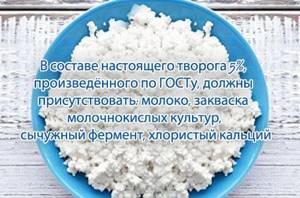
Harm from cottage cheese 5%
Fresh cottage cheese can cause allergic reactions in those who have individual intolerance to milk protein. Sour cottage cheese is a real threat to digestion; its consumption leads to severe poisoning.
Selection and storage of cottage cheese 5%
Almost all manufacturers offer cottage cheese of varying fat content, so the choice of 5% cottage cheese is a matter of personal taste and preference (calorizator). When purchasing cottage cheese, you must carefully study the production date and expiration date so as not to buy a stale product. Cottage cheese should be stored exclusively in the refrigerator, after opening the package - no more than a day.
Cottage cheese 5% in cooking
Cottage cheese 5% is a universal product that is equally good as an independent dish or as an ingredient in salads, fillings for pies and pancakes, a base for making cheesecake, curd puddings and casseroles. Cottage cheese goes well with fresh berries, sour cream, jams, honey, cinnamon or, for example, herbs and garlic.
For more information about cottage cheese, see Copying this article in whole or in part is prohibited.
About the benefits and harms of sandwiches
The rhythm of modern life. Circulation. Crazy speeds. And everything needs to be done in time. And there are clearly not enough hours in the day for...namely sleep and lunch. If it’s really impossible to carve out an hour or half an hour or a minute for a gourmet lunch with the “Queen of England,” then your style is sandwiches. Like a snack in between, like that same lunch with the queen. On a slice of your favorite rye with bran or any grain bread, a slice of real ham or your super-favorite cheese, a thin slice of a slice of tomato-cucumber, a ring of bell pepper and a sprig of herbs... mmmmm... Can you feel the aroma? With a cup of your favorite aromatic tea or stylish, delicious coffee. And you enjoy a couple of minutes of peace. In these moments, in your fantasies, you can move in space and through time! Something like meditation. Luxuriously!
But there are a couple of flaws in eating delicious sandwiches. Let's talk about them. Let's talk about that same calorie content. “Borodinsky” bread, preferred by many, has 245 kcal, and a white loaf - add another 50 kcal. And if you make a full-fledged sandwich with traditional sausage and cheese, the calorie content soars by an order of magnitude.
Let's choose the best option for benefits and those same calories.
A traditional cheese sandwich has 240 kcal. And there is a huge benefit for the body if it receives this energy boost before lunch. It is at this time that he (the body, not the sandwich) has a “problem” - he does not have enough carbohydrate energy.
Product Description

Semi-hard rennet milk cheese. It is made from pasteurized cow's milk. During production, ferment and rennet are added to premium quality milk. If there is a lack of natural color, natural dye is used. This happens in winter, when animals do not receive the required amount of vitamins. They are produced in the form of low cylinders or bars.
On a note!
Weight reaches 18 kg.
The cheese is light yellow in color. The structure is dense and plastic. The product cuts well and does not stick to the knife. The taste is creamy, aromatic, with pronounced sourness. The photo shows Russian cheese with many large, uneven eyes. It has a dense crust, on which traces of linen fabric are visible. This means that during production the delicacy was placed on it.
Cheese composition
The ideal composition of delicious Russian cheese includes pasteurized cow's milk, rennet, calcium chloride, salt, annatto extract.
The composition of the finished Russian cheese also includes:
- proteins;
- fats;
- carbohydrates;
- vitamins B 2, B 6, B 12, A, D, PP;
- minerals: magnesium, zinc, phosphorus.
The taste is high in fat content and cannot be felt at least 50-51%. At the same time, the protein content reaches 23 g per 100 g of product.
Nowadays, there is often a cheese product on the shelves that consists of unnatural ingredients. It is significantly inferior in price, which indicates low quality. The chemical composition includes sorbates, nitrates, phosphates. They do not benefit the body and indicate a violation of production technology.
Calorie content
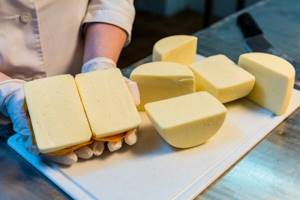
100 g of dairy product contains 363 kcal. The high calorie content does not allow the product to be consumed in large quantities. The extra calories in Russian cheese can lead to weight gain. Nutritional value: proteins - 23.2 g; fats – 29.5 g; carbohydrates – 0 g. Sandwiches with it for breakfast highly saturate the body with calories. It is enough for adults to eat 120-140 g of this fermented milk delicacy.

